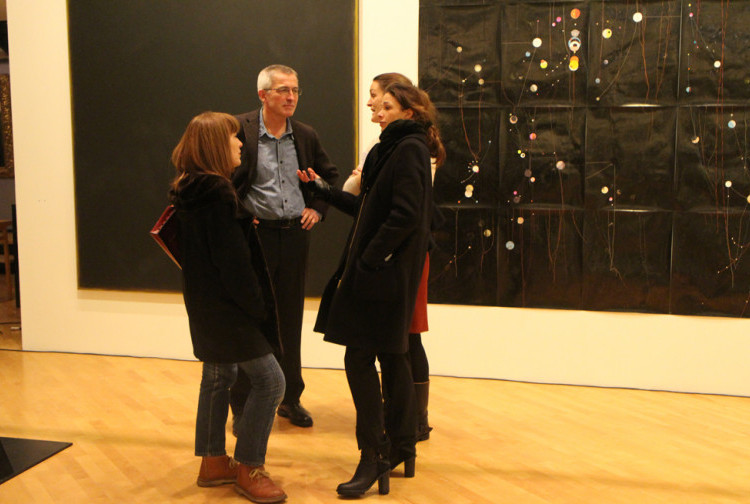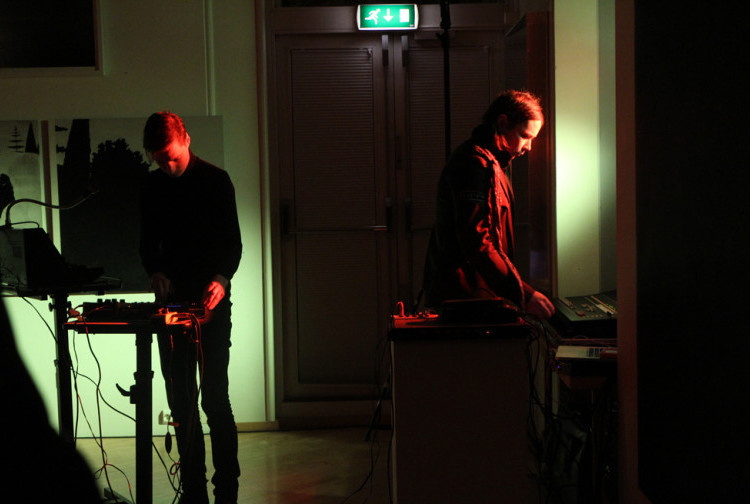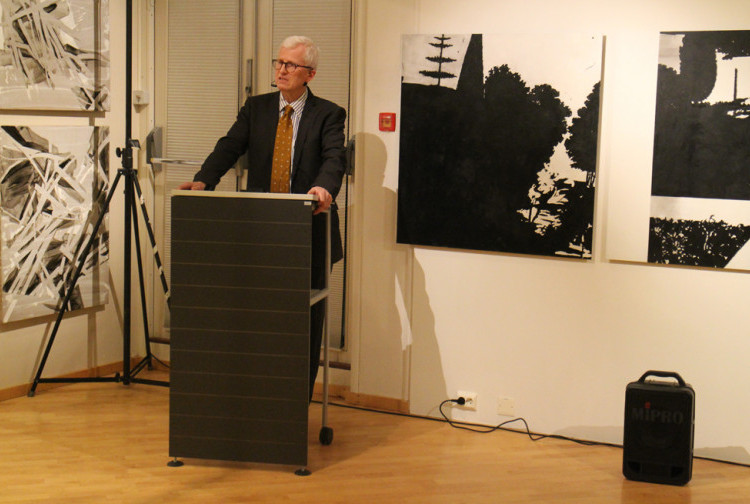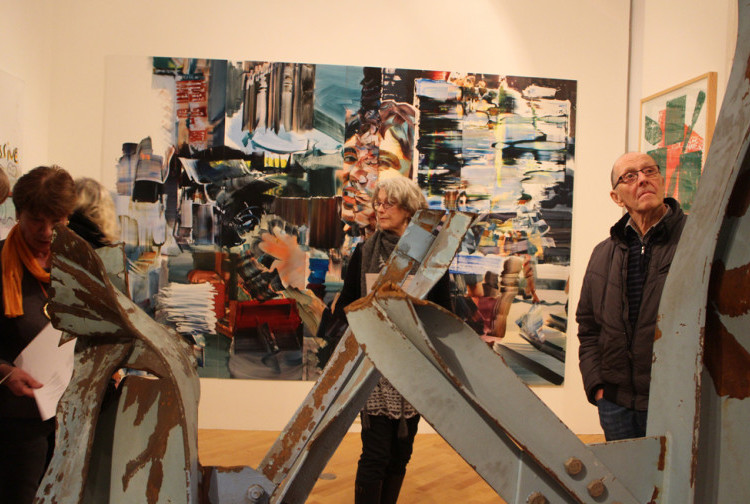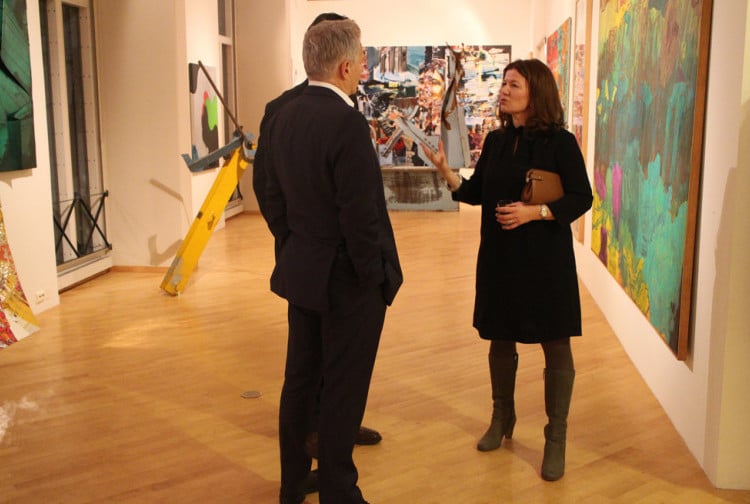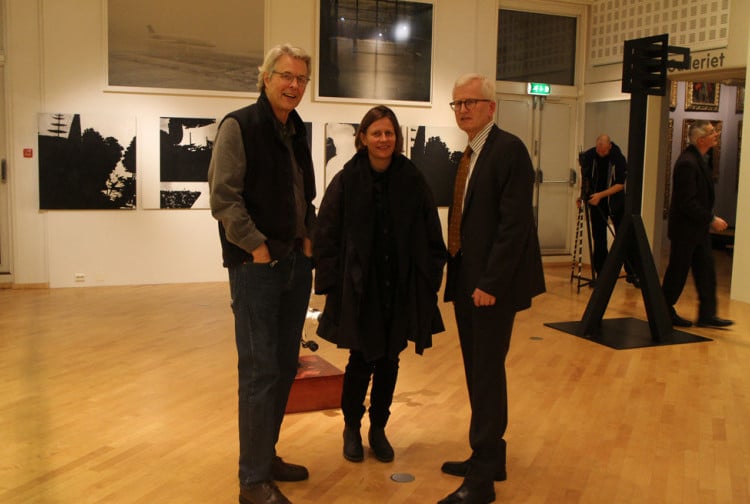Third act - Selected works from Nordea Norway Art Collection
This is the third time Nordea Norge Kunstsamling is presented in an art institution. In 2007, the entire collection was until then presented at Henie-Onstad Kunstsenter at Høvikodden. The exhibition and the magnificent book that was published were named Clusters.
In 2010, a rich selection was presented at Haugar Vestfold Art Museum in Tønsberg under the title Clusters - Remix, and in 2014 a Third Act will take place in Drammens Museum's exhibition rooms in the Lyche Pavilion.
Nordea Norge Kunstsamling as it stands today is a work that has been going on since 1999, a new collection that continues the art commitment in Kreditkassen's art collection. The collection is built up by an Artistic Council under the leadership of the bank's Sigurd Carlsen in collaboration with artist Sverre Wyller and art historian Åsmund Thorkildsen.
The collection consists of Norwegian and international contemporary art purchased after the council has closely followed the Norwegian gallery scene and main lines in foreign art. The goal has been to gather relatively few artists, but rather gather these in depth. This fundraising profile has led to Nordea Norge Kunstsamling having representative collections of some leading Norwegian contemporary artists and works by foreign artists that are found in few other Norwegian collections. The council has been completely free in artistic matters. It has been a conscious choice to build up a collection that is not too similar to larger Norwegian private collections and other company collections. Not least because it has been important to collect foreign art.
The titles Clusters, Remix and Third Act reflect the collection's composition and function. For all the years the collection has existed, it has served as a temporary decoration of common areas, offices and meeting rooms in the bank. The whole idea of building "clusters" of related works has to do with the flexible and pragmatic use the bank makes of these works. Often a meeting room has room for three works, a corridor or a reception area between four and six works, etc. The collection contains many possible cross-connections that can provide a connection and visual excitement even in small groups. It is also possible to create smaller exhibitions with different themes, which has led to a number of special exhibitions in the lobby of Nordea Norway's head office at Majorstua in Oslo. The theme exhibitions, which the collection's administrative staff member Svein Olav Øversveen organizes, are open to the public.
It has been and is a wish of the bank that the art collection be disseminated. Works are lent to changing group exhibitions in art galleries and galleries. The external exhibitions, where only samples from the collection are shown, are part of the important dissemination work also outside the capital. A "re-mix" is simply a new way of putting together groups of works, while the idea of a "third act" is based on the fact that there are no neutral and lasting ways of assembling contemporary art. The curator's selection and installation is always something new and different premises give the works a way to appear as a special for the current course of the rooms in the various museums and art galleries. A curated exhibition is directed, whether consciously or unconsciously, and an exhibition is a place where works are staged to play together in a new way among themselves and in relation to the audience.
Selection and installation in Drammens Museum is based on knowledge of the three rooms that the exhibition will fill in the Lyche pavilion. The rooms will have different expressions and sounds, much like the movements of a concert or a sonata. Selection and placement is done in a way that hopefully makes the audience reflect on how the actual situation at the exhibition affects their experience.
Tips on Drawing
Nordea Norge Kunstsamling as it stands today has been built up over the last 14 years. The principles for the work have been to collect several works by some selected individual artists, both Norwegian and foreign. Around these, individual works have been purchased by artists whose expression and medium relate to some of the works of art that are collected in slightly larger numbers. Thus, there are "clusters" of works of art that are reminiscent of each other, which have a kind of artistic "family resemblance". The fact that there will be clusters or "clusters" is the reason why the first presentation of the entire then Nordea Norway Collection at Henie-Onstad Art Center at Høvikodden was called Clusters.
There are several reasons for this collection strategy. First, a private company collection can have no ambition to collect representatively. Secondly, the collection is used actively in the bank's premises in that meeting rooms, corridors and the entrance hall at the head office in Oslo are temporarily decorated, and then it is suitable with groupings of 3 or 5 or 7 pictures that have something in common. In addition to this, smaller exhibitions are arranged in a small gallery section in the entrance hall to the head office.
The collection has been shown twice before in art museums. First Clusters at Høvikodden in 2007, then a large selection that was shown with the title Clusters - Remix at Haugar Vestfold Art Museum in 2010. The exhibition in Drammens Museum is the third time. The title of the exhibition is the Third Act. This is because this is the third time the collection has been exhibited in a museum, and this time there are 3 rooms. In this way, the exhibition becomes a 3rd act, and at the same time an exhibition in 3 acts. The fact that an expression from the theater has been chosen has to do with the fact that every exhibition is a staging. There is no neutral and place-independent way to display visual art. The senses also take over the rooms and this affects the whole of the art experience. Every installation does something with the pictures, so that one and the same picture is experienced a little differently every time it comes in a new context, with other pictures and in other rooms. Therefore, the selection of works of art and the spaces and the context in which they are displayed in a deliberately planned action on the part of the curator. The alternative is chance and indifference and it's just nonsense. (Coincidence as an artistic strategy is something completely different and then the curator must be very precise in the work of creating an exhibition).
The exhibition is structured as three very different groupings in three very different rooms. First the audience enters a small access room, then they can enter a large illuminated room or a long narrow side gallery with good, indirect light from the north.
The first room could well have been called "Welcome", because here you meet pictures of faces that look straight at the spectator or at something in the picture room. The faces are cheerful or thoughtful. There is a positive and open atmosphere in the room. A small painting can not be seen as soon as you enter. It hangs to the left and faces the front towards the opening towards the large room. It is only when you are inside this room and look back and walk in the direction of the opening that you look directly at a male figure who snaps a photograph directly in front of the person walking towards the picture. Just as surely as the spectator looks at and saves images, just as surely the image looks at and saves the image of the spectator who is "snapped" by the man with the camera in the picture.
The large room is "the black room". It is not a black box as one has in the theater, but it is a minor melody in many of the art expressions. The atmosphere is heavy, dynamic and with visual drama. In this room, in addition to the sculptures and relief, there is a mixture of techniques. There is painting, photography and drawing, printing and collage on paper. Each of these techniques has its own visual emotional register that the audience senses if they take the time to look not only at the subject of the image, but also at its material surface. This material-based sensitivity is experienced as a quality in itself, as something positive and tangible. But also experiencing the difference between photographic paper with ink, photographic paper with a photographic imprint, coarse paper with grease pen and charcoal and smoother paper with printed text means something. The assembly draws attention to the differences between the different surfaces and thus the awareness of and experience of each individual surface and each individual's irreducible and irreplaceable quality is enhanced.
The obscure and the heavy often appear as abstract qualities. It is experienced as a basic sound in the room. Sometimes it is experienced in the form of fingerprints and expressed in a heavy, aging male body (John Coplans), other times as a rhythmic movement in a visual choreography of elements (Barry Le Va), again other times in the form of simple written statements (Bruce Nauman). Although the simple word and phrase, NO and CLEAR VISION (written in reverse), are easy to read and understand, these word pictures also have a clear physical appearance. They are given a physical form that gives a material weight in addition to the meaning of the statement. It could be a small collision of meaning, since Clear Vision might need a cleanup to get rid of some of the black ink left over after the words are drawn.
Mari Slaattelid's five silhouettes of a landscape taken from a Renaissance painting and the nocturnal atmosphere in Dirk Stewen's sewn on confetti starry sky give a late romantic twilight atmosphere. The sculptures in this room give either a crunchy, compact and heavy impression, or of something stiff and rigid, and somewhat distorted. The expressions in the room are all more or less abstract, even the photographs show such strange and fragmented parts of the visual world that they become more read as signs than as depictions of holistic situations. They complement each other and together provide the actors in a dense and shadowy drama that each gets to interpret for themselves. The audience can think about how these works of art, in this context, affect their experience of the room and the images in it.
The third, long and narrow room is the most colorful and dynamic room, and here it is in major. The atmosphere is fresh and uplifting. It's lush here. The two sculptures (by Sverre Wyller and Ida Ekblad respectively) are very powerful. They are composed of strongly distorted parts from monumental industrial buildings. Huge dimensions in H-beams and rebar are bolted and welded together. The sculptures show remnants of strong colors and it is rust and jagged edges after the cutting flame that have cut the parts during demolition. The distorted elements are the result of machines that used formidable force to tear down the buildings and pushed down and tore apart what had once been built. The practical and functional are here given reuse as aesthetic objects, as useless artefacts.
Some of the works are on the borderland between relief and painting (Tilman Hornig), while others are monumental paintings in an abstract-expressionist style. The sculptures, reliefs and paintings are related in style, typical examples of post-war expressionist expression. Some of the paintings are very large (Per Kirkeby, Troels Wörsel, Christian Blandhoel, Bjarne Melgaard and Kira Wager). The two woodcuts signed by Mattias Mansen are also very large to be graphic prints. Usually we see such large paintings and prints in large rooms with a good distance to the work. Here you have to see them up close. Not only because the space is cramped, but also because in some places sculptures overshadow the image if it is to be seen from afar. You are thus moved into the immediate area of the images. You get close to the pictures and then something new happens with the art experience.
Seeing large works up close increases the intensity of the color experience. The experience of visual art seen as such, close to large flakes gives a physical and physical, not just an optical, experience. By going up to painting, graphics, photography and sculpture, the work's physical expression and our awareness of standing in front of a work shaped by a human being to be seen and felt by an entire human being will be almost intrusively strong. The painting and the sculpture become not just an image, a projection on a screen, but part of a place, where the whole situation between work and spectator is charged with energy. It is this feature of the post-war large, abstract painting that made it possible to look at painting a picture and experiencing a painting as something performative, an event that takes place in full, human size and in real time. The large painting and painting action of Christian Blandhoel and which can be seen on the TV screen next to the brush guitar is a result of just that realization. In the United States in the early 1950s, this was called action painting. The painter's movement and the spectator's movement in front of the large painting were seen as a kind of choreography, that the image choreographed the spectator's form of experience as a repetition of the painter's action. We also see action art in the two mirrors that stand on the floor leaning against the wall. These are the result of the artist Tilman Horning carrying out the act of smashing the mirrors with powerful hammer blows. That action is immediately followed by the inscription, where he writes a commentary on the work with lipstick. That it is either surprisingly beautiful, «Awesome», or that it is sold, «Sold». The works were performed as a performance during the art fair in Basel in 2012. Nordea's artistic council, together with others, witnessed the performance and had just before this talked to the artist - who is represented by as many as 7 works in the collection - bought a mirror and ordered a new one. He responded to the order by accepting the purchase by writing "Sold" on it as soon as it was broken, and thus a work of art that was immediately sold. With this he also points out how important the transaction is in the modern art world, where buying and selling and art-critical assessments ("it's awesome!"), Help to provide fuel for art production.
At this exhibition, all this happens in the 3rd and last act of the exhibition of the same name. It has long been known that the experience of art and architecture depends on the spectator's position in relation to what is to be seen. Changed position gives a changed experience. For example: If something hangs high, people will go backwards to see it better. In this exhibition, the works' position and position will engage the viewer in an active reflection on their own experience. The spectator is engaged by the works. In this way, not only are the images staged, also each individual's experience becomes a staging in dialogue and encounter with precisely these works in precisely this constellation in this particular exhibition. This only lasts as long as the exhibition lasts. The next time an exhibition of Nordea Norge Kunstsamling is made, something else will happen. - At the exhibition, the public can buy the book Clusters, where many of the works are described in greater detail.
The curator of the exhibition is Åsmund Thorkidlsen, who has selected works and placed them where they hang. For the sake of order, it is noted that he has been involved in building up the Nordea Norway Art Collection for the past 14 years, was involved in the installation of Clusters at Høvikodden and curated the exhibition Clusters Remix at Haugar Vestfold Art Museum.
Åsmund Thorkildsen
curator and museum director
Venue
Monday to Friday 11.00 - 15.00
Wednesday 11.00 – 18.00
Saturday 11.00 – 16.00 (free admission)
Sunday 11.00 – 16.00
Supported by


